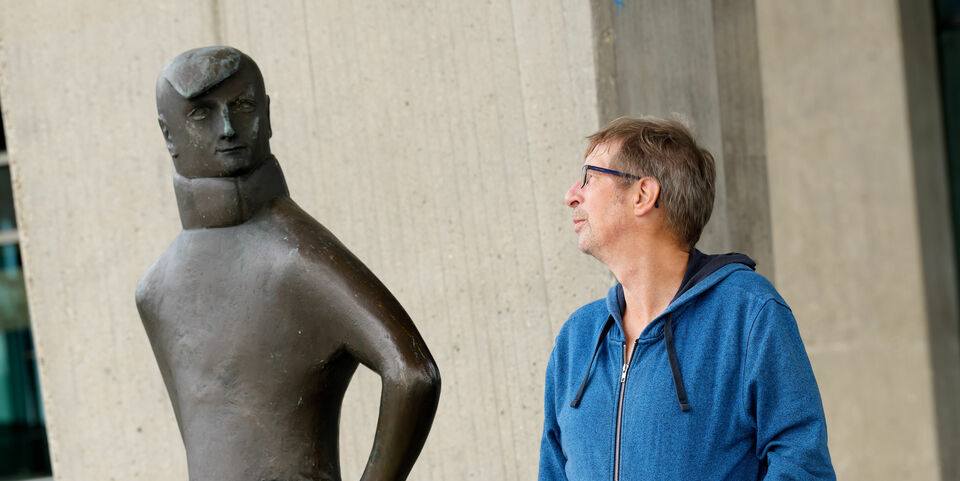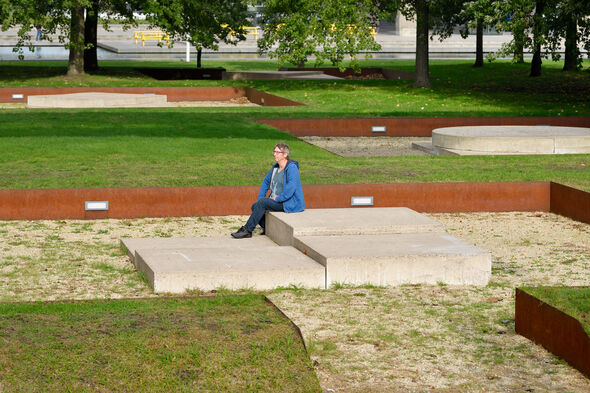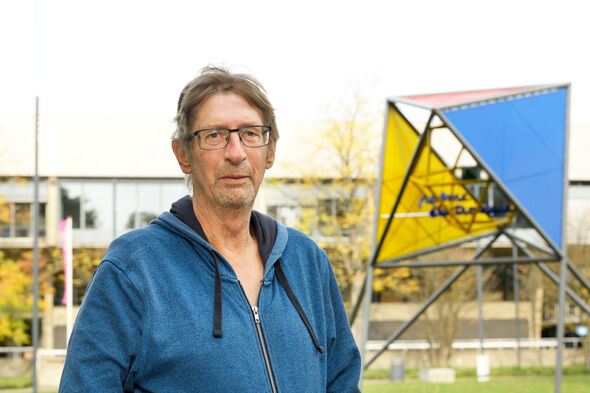Twenty years looking after a unique collection
A folder with twenty photographs of artworks. This was the meagre beginning from which Gerard Verhoogt had to make an inventory of TU/e’s art collection in 2000. He was the university’s first paid curator and spent the first years mostly looking in basements and carrying out overdue maintenance. At his farewell from TU/e - which was planned for 1 October but had to be postponed due to corona - he looks back with satisfaction on how that “unique collection” gained profile.
A fragile, small airplane designed by Antwerp artist Panamarenko, graffiti art by rock musician and painter Herman Brood, a remarkable machine made by Gerrit van Bakel, a provocative and inspiring sculpture by Tajiri, or a wall tapestry from world famous graphic artist Escher. It can all be found on display or on the walls somewhere on the TU/e campus, and it’s only a small selection from a very extensive art collection that also includes much graphic work, more than nine hundred items.
“Only a few people at TU/e know that our university truly has one of the most remarkable art collections of all Dutch universities,” says outgoing art curator Gerard Verhoogt. “That’s not just my opinion, but also that of my colleagues at the other institutions.” He describes his early days as curator as “one big search.” A proper inventory hadn’t been made. “A folder with twenty photographs was put on my desk and that was about it. I actively had to go out and look for what we had in possession, where exactly it was located, who the artist was, and in what state it was in.”
Art detective
It didn’t take him long to make an inventory of the large sculptures on the campus. But locating the smaller sculptures and graphic art objects - which had gotten scattered throughout the buildings in the course of thirty years - required him to go about his work like some kind of art detective. “We went to each building to see what was on display there and what was hanging on the walls, and above all to ask what had happened to certain pieces. Partly with the help of old editions of TH Berichten, Cursor’s paper forerunner, I got an idea of what was supposed to be present in those buildings, but some objects couldn’t be found. Some of them had been given away as a gift to professors upon their departure. More often, they had ended up in the basement of a building because no one knew what to do with them. We recovered many graphic art objects there.”
After two years, Verhoogt had a reasonably fair overview of the collection, and realized that some artworks were missing. “Five sculptures had disappeared without a trace, some were probably stolen, they were never recovered.” Other problems involved artworks that TU/e had received from the Regulation for Artists of Visual Arts (the so-called ‘BKR-regeling’) in the mid-1980s. “Government institutions, including TU/e, had the opportunity to select a number of artworks for a long-term loan. When the university received a letter in 2003 demanding the return of some of these objects, only a handful of people remembered what exactly had been selected at the time. Fortunately, it led to only a small fine,” Verhoogt says.
Much of the graphic art had ended up in the basement of a building because no one knew what to do with them
Large maintenance
He also got started with maintenance and restoration of the sculptures on the campus ground outside. “No one had paid attention to that since the sixties, when a new artwork could be purchased after completion of a new building. Until 2000, someone in the Art Commission did my job kind of on the side, and it was mostly out of charity. I had to find specialists who could help me with restoration work. Such as on the concrete artwork ‘Wording’ by Piet Killaars, which is located in the pond next to Atlas. It had cracks, and white spots had appeared on its surface. Concrete degradation, a simple case of weathering, or were there other causes? Try and find a specialist for that. I eventually managed to find someone, and the artwork is now in fine condition again.”
Sometimes he also had to prevent art from ending up in the waste container, such as in the case of the floor reliefs by Ad Dekkers. “They were once applied to the roof of the Computing Center, now the Laplace building. Construction workers were already making preparations during a renovation to dispose of the four reliefs - the only ones Dekkers ever made of concrete - because no one recognized them as art. I managed to prevent that and found a nice spot for them between Vertigo and the Matrix building. They have become one of my favorite artworks.”
Verhoogt also managed to restore the installation ‘Objet Mathématique’ by Le Corbusier. “The only remaining object of the famous Philips Pavilion, designed for the 1958 World Fair in Brussels, was also a candidate to be turned into scrap. Architect Arie van Rangelrooy heard that it stood in the way at Philips and it was via him that art center Kunstlicht in de Kunst gave us this characteristic beacon, which is located at the campus entrance, for a long-term loan. When we wanted to have it painted in its original colors, we contacted the foundation in Paris dedicated to the conservation of Le Corbusier’s work. The original paint no longer existed, so we needed to have it specially made.”
In 2001, a catalogue entitled ‘Ensemble’ was published, under supervision of Verhoogt and with his participation. “A book of pictures,” he says, which for the first time showed employees and students the richness of the art collection they unknowingly pass by every day. A new catalogue, ‘Art Connected,’ was published ten years later. It includes a coherent and historical description of the collection. “Placing the artworks in the context of various national and international trends in art only further emphasizes just how valuable this collection is,” Verhoogt says.
Day of Art
He is also proud of the Day of Art, another initiative aimed at making the collection more visible. “We started with that in 2008. During that day, we would focus on one artist of whom we have important works in our collection. Different events were organized, including workshops with students. The Day of Art took place annually until 2013. It would be great if this event were to be given new life one day.”
This week, Verhoogt will speak with his successor, whom he will show the ropes in the coming period. Which artworks have become his love babies over these last twenty years? “I feel a love for the floor reliefs of Ad Dekkers, but also for Panamarenko’s frail ‘Umbilly I’ (hangs above the model workplace of the Built Environment department in Vertigo, ed.), as well as for the mysterious ‘Tarim Machine’ from Gerrit van Bakel (can be found in a foot bridge between Gemini-Noord and Gemini-Zuid, ed.). But we have so many beautiful things here, people really should discover that for themselves. That is why we’ve been very focused these last year to put more of our graphic work on display in public spaces.”
Finally, the key question: what could be the collection’s estimated value? Verhoogt: “I’ve never really concerned myself with that question, to be honest.”




Discussion